skip to main |
skip to sidebar
I'm afraid this report, covering the end of 2014 and 2015 is delayed (my fault), but in the interests of completeness, it's finally being issued. This report is based on information provided by Dr. Hla Tun, who also supplied the photographs.
Shwe Sin Minn
In October 2014, Dr. Hla Tun arranged for one of the guides working on the 'Road to Mandalay' ship to make a donation towards teachers' salaries at the Shwe Sin Minn Nunnery, Orphanage for Girls and Monastic Secondary School. Guests from the ship also donated rice, peanut oil, garlic and onions. Shwe Sin Minn is situated in Maymyo, up in the hills, around two hours driving from Mandalay. Maymyo was very popular with the British in summer, because of its cooler location.
 Teachers' salaries being donated to one of founders of Shwe Sin Minn.
Teachers' salaries being donated to one of founders of Shwe Sin Minn.
 Girls at Shwe Sin Minn reciting a poem for their visitors.
Girls at Shwe Sin Minn reciting a poem for their visitors.
A report on my first visit to Shwe Sin Minn in 2011 is here My pictures of this visit and a later visit in 2013 are here.
Traditional Ceremonies
The following pictures show a procession in connection with traditional ceremonies. These are arranged in connection with Noviciation for boys and Ear Piercing for girls and feature decorated, gold-painted oxcarts.
 A procession of decorated oxcarts.
A procession of decorated oxcarts.
 Another view of the procession.
Another view of the procession.
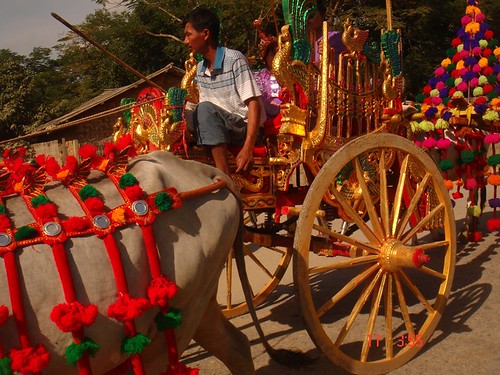 Close-up of one of the gold-painted oxcarts.
Close-up of one of the gold-painted oxcarts.
I'd been lucky enough the see this ceremony in 2012 at Moe Dar (report here), in 2013 at Bagan (briefly mentioned here) and in 2013 at Mandalay (briefly mentioned here).
Taung Be School Stationery Distribution and Concert
Taung Be school is only a few minutes walk from the Bagan Medical Clinic and the 'Road to Mandalay' landing stage in Bagan. On 25th October 2014 Dr. Hla Hun, accompanied by Guests from the ship, visited to distribute stationery to about 371 students. The picture below shows Grade 5 students from the school, dressed in traditional Shan Costume, performing a traditional dance from Inle Lake.
 Taung Be Concert
Taung Be Concert
There's an earlier report on stationery distribution at Taung Be during 2013 here.
Aung Myae Oo Monastic High School
On 16th December 2014, Dr. Hla Tun visited this school in Sagaing which has 2,092 students from Grade 1 to Grade 11 of whom 691 are boys and novices and 1,401 are girls and nuns. There are 43 teachers on the staff.
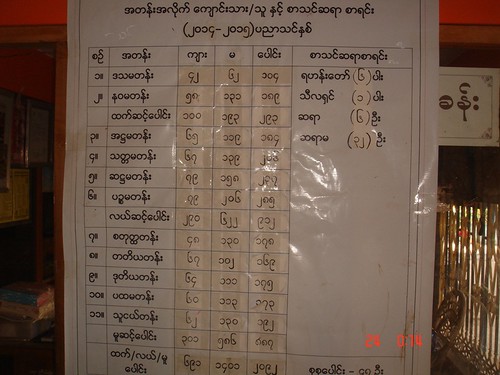 List of students.
List of students.
On that date, students from Grades 5 and 9, most of whom were nuns, were sitting their State Examinations.
 The State Examinations in progress.
The State Examinations in progress.
The Doctor made a donation to one of teachers, watched by small children (who were on holiday because of the State Examinations) and the Monk.
 Dr. Hla Tun making the donation.
Dr. Hla Tun making the donation.
Christmas Eve, 2014
On Christmas Eve, 15 orphans from Nar Ga and Tribal Orphanage, Mandalay, came on board the 'Road to Mandalay' to perform Christmas carols for the guests. The performers ranged from a 7 year attending Grade 3 to a 16 year in Grade 11. Among them, there are 6 orphans from the Nar Ga Tribe/Ethnic and 9 from the Chin Tribe/Ethnic. The group was led by a teacher, Ms. Ann Ja Taung who is also Chin Tribe/Ethnic.
 Singing carols to the Guests in the restaurant of the 'Road to Mandalay'.
Singing carols to the Guests in the restaurant of the 'Road to Mandalay'.
After the performance, Dr. Hla Tun made a donation to the Orphanage.
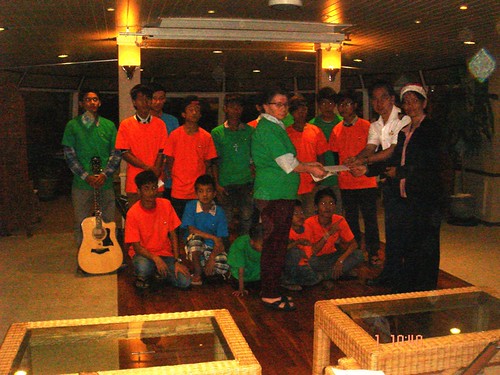 Dr. Hla Tun making a donation to the Orphanage.
Dr. Hla Tun making a donation to the Orphanage.
Ko Dut Drop In Centre
Donations have allowed improvements at this Drop In Centre in Mon State. The planned first floor has been brought into use by constructing a new floor and access stairs. The exterior has also been painted. These pictures, taken in February 2015, show the work in progress.
 Ko Dut Drop In Centre: Improvements funded by donations - upper floor with access stairs being added.
Ko Dut Drop In Centre: Improvements funded by donations - upper floor with access stairs being added.
 Ko Dut Drop In Centre: Improvements funded by donations.
Ko Dut Drop In Centre: Improvements funded by donations.
I first visited Ko Dut in 2014 and there is a report here. I returned in 2015 (and inaugurated the new upper floor by the simple process of sleeping on it) as described here.
All my posts on Educational Support in Burma can be found here.
Ty Gwyn is a small commercial woodland in north Wales extending to about 27 hectares (66 acres). When I first became involved the trees, mainly Sitka spruce and Lodgepole pine, were already fairly mature in various 'compartments' of different ages. You can find all my posts about Ty Gwyn here, with links to pictures.
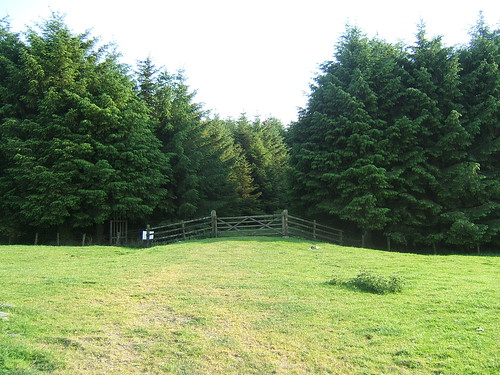 The entrance to Ty Gwyn in 2006.
The entrance to Ty Gwyn in 2006.
Timber extraction in 2009/2010
About half of the site was felled starting at the end of 2009. Because of poor weather condition, felling was not completed until 2010. That operation is described in the posts Harvesting at Ty Gwyn, Ty Gwyn ships out Timber and Progress on Harvesting at Ty Gwyn. The felled area was replanted with Sitka spruce and broadleaves to encourage bio-diversity. After a few months, the new planting was establishing well, as shown in the pictures here.
 The entrance to Ty Gwyn in 2010, with the area on the left felled and re-planted.
The entrance to Ty Gwyn in 2010, with the area on the left felled and re-planted.
Timber extraction in 2014
Following an inspection visit in February 2014, it was decided to seek a Felling License for a further 10 hectares of mature trees. That's described in the post Ty Gwyn Update (with some rather belated notes regarding the completion of the felling and replanting in 2010).
The felling operation started in July 2014 and is described in posts Timber Extraction at Ty Gwyn and Harvesting continues at Ty Gwyn.
 The entrance to Ty Gwyn in 2014, with the area on the left growing well and the newly-felled area on the right.
The entrance to Ty Gwyn in 2014, with the area on the left growing well and the newly-felled area on the right.
Replanting and Site Maintenance in 2015
On completion of the felling, 'Ground Preparation' was carried out, ready for re-planting. Although Rob, the forester, had originally hoped to re-plant early in 2015, for various reasons this did not occur until mid-November when around 18,000 Sitka spruce cell-grown seedlings were planted.
I visited Ty Gwyn on 26th November 2015 and met Rob and Gareth on site. Gareth had arrived that morning with his Volvo EC140CL excavator on a low-loader and had already cleared one of the access roads within the plantation. You can view Volvo's specification for the EC140 range of crawler excavators here.
 Maintenance being carried out by the excavator near the pool.
Maintenance being carried out by the excavator near the pool.
Although most of the re-planting had been carried out in very wet and windy conditions, I was lucky on my visit - rain earlier in the day had stopped, the wind had dropped and later in the day the sun came out.

One of the new Sitka seedlings, just a few days after planting.
Pictures of Ty Gwyn
You can find all my pictures of Ty Gwyn here.
I'm afraid this report, covering the end of 2014 and 2015 is delayed (my fault), but in the interests of completeness, it's finally being issued.This report is based on information provided by Dr. Hla Tun, who also supplied the photographs.
Bagan Medical Clinic
As commented in earlier reports, the number of patients arriving for treatment tends to fall in summer, because the heat adds to the problems of travelling to the clinic. Winter in Burma is from November to February and Bagan has especially low temperatures because it is situated in the 'Dry Zone'.
The 'Dry Zone' is the name given to the microclimate of the region lying between the Shan Plateau to the east and the low coastal ranges to the west extending south from Mandalay and taking in much of the central plains where Bagan is situated. Because of this "rain shadow", Bagan and Mandalay receive, on average, less than one third of Yangon's yearly rainfall.
The Bagan Medical Clinic normally opens on Friday, Saturday and Sunday each week but patients from remote areas may have travelled up to 200 miles to reach the clinic and start to arrive as early in the week as Wednesday evening.
On the Thursday 18th December 2014 Dr. Hla Tun, assisted by two other doctors, started treating patients because there were already around 580 people waiting.
 View of the verandah of the third (and currently largest) clinic building, showing some of the waiting patients.
View of the verandah of the third (and currently largest) clinic building, showing some of the waiting patients.
By the time Dr. Hla Tun stopped treatments for the day at one o'clock on Friday morning, the three doctors had dealt with 250 patients. As the night was cold, Dr. Hla Tun checked on the sleeping patients and took the pictures reproduced below. Although a substantial dormitory for waiting patients is now in use, donated by The Ultimate Travel Company and its clients, the large number of patients waiting for treatment meant that people were sleeping in a number of other areas, including the Monastery and its food store (along with dried onions, potatoes, chillies, garlic, carrots and cabbage).
 The Ultimate Travel Company and its clients donated a dormitory building for waiting patients in 2013. This picture (taken at 01:30 in the morning) shows about 70 patients, with one elderly lady unable to sleep because of the cold.
The Ultimate Travel Company and its clients donated a dormitory building for waiting patients in 2013. This picture (taken at 01:30 in the morning) shows about 70 patients, with one elderly lady unable to sleep because of the cold.
 Patients sleeping in the upper storey of the 200-year old Monastery.
Patients sleeping in the upper storey of the 200-year old Monastery.
 Patients sleeping in the Monastery food store.
Patients sleeping in the Monastery food store.
 A green carpet was laid on the floor in front of the clinic building to provide additional sleeping space.
A green carpet was laid on the floor in front of the clinic building to provide additional sleeping space.
 Waiting patients sleeping in a light truck, faces covered with blankets.
Waiting patients sleeping in a light truck, faces covered with blankets.
The monastery ensures that waiting patients are provided with a hot lunch each day. Preparing the food is a major undertaking - on the previous Saturday 13th December around 420 meals were served!
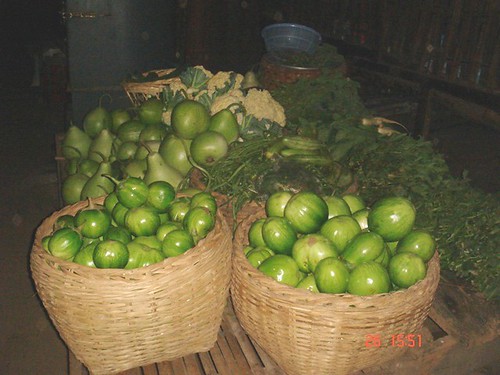 Vegetables will be mixed with dried fish and cooked by a monk assisted by volunteers to provide the free lunch for waiting patients at the Clinic.
Vegetables will be mixed with dried fish and cooked by a monk assisted by volunteers to provide the free lunch for waiting patients at the Clinic.
Bagan Medical Clinic treated 5377 patients in November 2014 bringing the total number of treatments carried out since the clinic opened on 6th August 2011 to 124,178.
You can find all my reports on the Bagan Medical Centre here.
 Teachers' salaries being donated to one of founders of Shwe Sin Minn.
Teachers' salaries being donated to one of founders of Shwe Sin Minn.
 Girls at Shwe Sin Minn reciting a poem for their visitors.
Girls at Shwe Sin Minn reciting a poem for their visitors.
 A procession of decorated oxcarts.
A procession of decorated oxcarts.
 Another view of the procession.
Another view of the procession.
 Close-up of one of the gold-painted oxcarts.
Close-up of one of the gold-painted oxcarts.
 Taung Be Concert
Taung Be Concert
 List of students.
List of students.
 The State Examinations in progress.
The State Examinations in progress.
 Dr. Hla Tun making the donation.
Dr. Hla Tun making the donation.
 Singing carols to the Guests in the restaurant of the 'Road to Mandalay'.
Singing carols to the Guests in the restaurant of the 'Road to Mandalay'.
 Dr. Hla Tun making a donation to the Orphanage.
Dr. Hla Tun making a donation to the Orphanage.
 Ko Dut Drop In Centre: Improvements funded by donations - upper floor with access stairs being added.
Ko Dut Drop In Centre: Improvements funded by donations - upper floor with access stairs being added.
 Ko Dut Drop In Centre: Improvements funded by donations.
Ko Dut Drop In Centre: Improvements funded by donations.












